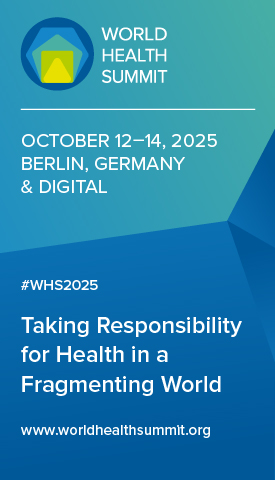For a safer future
As the world reels from Covid-19 and fights a spreading monkeypox outbreak, investing in National Public Health Institutes at a global and local level is a deliberate choice to build a safer future for everyone
The year 2022 has proven to be another challenging year for global health. While the continuing fight against Covid-19 has taken its toll on health systems across the world, a monkeypox outbreak with more than 50,000 confirmed cases had spread to over 100 countries by 10 September 2022. The war in Ukraine and other conflicts have led to millions fleeing, thousands dead and hundreds of health facilities destroyed. The resurgence of polio and recent detection of Marburg in Ghana have reinforced the risk of emerging diseases.
However, this year also witnessed the development of three major global health security initiatives. The Intergovernmental Negotiating Body started its work on a pandemic accord in February, the newly created Financial Intermediary Fund for Pandemic Prevention, Preparedness and Response was launched in September and Tedros Adhanom Ghebreysus, director-general of the World Health Organization, presented 10 proposals for a strong and inclusive health emergency preparedness, response and resilience architecture in May.
These are ambitious, far-reaching initiatives addressing the future on governance, financing and delivery of responses to health emergencies. They require hard work, collaboration and sometimes fierce diplomacy. Yet, together, they represent an unprecedented opportunity for global health leaders to make the world safer by laying out an ambitious path for national and global contexts.
Strong health institutions
In the first edition of Health: A Political Choice in 2019, Dr Tedros highlighted that “universal health coverage is not just the best investment in healthier populations. It is also the best investment in health security.” The prescient nature of this statement has been evidenced by the Covid-19 pandemic. The resilience of health systems, as first responders, is a strong determinant of whether the world is prepared for the next health emergency. Therefore, our efforts to strengthen the global architecture must be underpinned with renewed interest and intentional focus on strengthening national health systems, thereby contributing to universal health coverage.
National Public Health Institutes play an important role in connecting the national and global public health system. As centres of expertise, NPHIs bridge the political decision makers and researchers by translating evidence into actionable insights while being firmly anchored in local contexts. Our best shot at dealing with any future health emergencies rests on having strong NPHIs everywhere.
However, health institutions cannot be expected to transform overnight. I have learnt this over the course of my career while working in various NPHIs, most recently while leading the Nigeria Centre for Disease Control between 2016 and 2021. The progress in strengthening Nigeria’s health security capabilities illustrates how much is possible. Just a few years before the pandemic, NCDC did not have a national public health reference laboratory, and Nigeria’s outbreak surveillance system to protect more than 200 million people was based on paper and Excel spreadsheets. Over five years, we focused on gaining political commitment, getting a legal mandate, securing investments from government and other sources, building a strong workforce, establishing functional partnerships and other factors. Today, the strengthened capabilities that were implemented have enabled Nigeria to respond effectively to public health threats, mitigate their impact and contribute to global health security.
Delivering meaningful change requires a long-term perspective. Investing in people and institutions can feel like a risk because the key performance indicators seem less quantifiable. But when a national public health institution is strong, supported and streamlined, then quantifiable outcomes follow.
Better understanding of risks
Some public health challenges cannot be solved by one country alone. An effective system to avert and manage pandemic and epidemic risks needs global collaboration. Monkeypox is an unfortunate but timely example: discovered more than six decades ago, the disease has evolved from a local outbreak to a global threat. The first case of spillover to humans was recorded in 1970. A generation later, the virus led to the first outbreak outside of the African continent. In 2017, the outbreak in Nigeria changed our understanding of the disease and highlighted its potential to spread as a major concern.
Despite these warning signals, global interest was limited. The epidemiological and clinical aspects of monkeypox remained inadequately characterised. Up until the outbreak in the United States in 2003, global research on the risk from monkeypox had an average of five or six publications per year. Afterwards there were more than 30 articles published on average.
In an increasingly connected world, we cannot afford to allow such gaps in our understanding. More importantly, these gaps in epidemiology, vaccines and therapeutics are too large to be addressed by one country alone. The recent monkeypox outbreak is a stark reminder of the need for a strong global fabric for collaboration, based on solidarity and trust. This is crucial if we want to share data on surveillance and disease transmission, develop effective medical and non-medical countermeasures, and ensure equitable participation in the benefits from research.
Collaborative approaches
Developing new approaches to bring together diverse and interdisciplinary national public health actors at a global level is a cornerstone of the WHO Hub for Pandemic and Epidemic Intelligence, which I have been leading since November 2021. It supports countries and regional and global actors to avert and manage public health threats through collaborative problem solving informed by better data and robust analytics. Embedded in the WHO’s Health Emergencies Program, it leverages the WHO’s convening power to foster an architecture of global collaboration and trust.
These global efforts would not be possible without sustained political commitment. As countries increasingly seek to put Covid-19 behind them, there is a real concern that the damage inflicted by it will soon be forgotten. In a world perpetually plagued by the threats of climate change, we do well to remind ourselves that this is a privilege we cannot afford. Global leaders need to act unanimously to invest at national, regional and global levels in preparing for future health emergencies. Globally, the right step is to strengthen the WHO. As Ilona Kickbusch eloquently stated in her 2021 piece for this series, “It is simple. The greatest potential for global solidarity lies with the WHO – an organisation that builds on its ownership by 194 countries.” Nationally, we need strong National Public Health Institutes that are fit to collaborate at a regional and global level.












